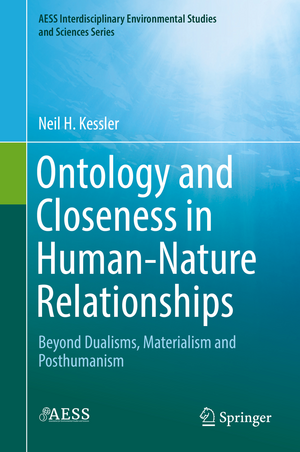Ontology and Closeness in Human-Nature Relationships: Beyond Dualisms, Materialism and Posthumanism: AESS Interdisciplinary Environmental Studies and Sciences Series
Autor Neil H. Kessleren Limba Engleză Hardback – 20 oct 2018
Given the diversity of fields and disciplines focused on the human-nature relationship, the topics of this book vary quite broadly, but always converge at the nexus of what is possible between humans and more-than-human beings. The discussion interweaves the influence of human/nature dualisms with the limitations of Deleuzian becoming and posthumanism’s new materialism and agential realism. It leverages interhuman interdependence theory, Charles Peirce’s synechism of feeling and various treatments of Theory of Mind while exploring the influence of human/nature dualisms on sustainability, place attachment, common worlds pedagogy, emergence, and critical animal studies. It also explores the implications of plant electrical activity, plant intelligence, and plant “neurobiology” for possibilities of relational capacities in plants while even grappling with theories of animism to challenge the animate/inanimate divide. The result is an engaging, novel treatment of human-nature relational ontology that will encourage the reader to look at the world in a whole new way.
| Toate formatele și edițiile | Preț | Express |
|---|---|---|
| Paperback (1) | 643.48 lei 6-8 săpt. | |
| Springer International Publishing – 19 ian 2019 | 643.48 lei 6-8 săpt. | |
| Hardback (1) | 649.87 lei 6-8 săpt. | |
| Springer International Publishing – 20 oct 2018 | 649.87 lei 6-8 săpt. |
Preț: 649.87 lei
Preț vechi: 764.55 lei
-15% Nou
Puncte Express: 975
Preț estimativ în valută:
124.36€ • 132.98$ • 103.68£
124.36€ • 132.98$ • 103.68£
Carte tipărită la comandă
Livrare economică 17 aprilie-01 mai
Preluare comenzi: 021 569.72.76
Specificații
ISBN-13: 9783319992730
ISBN-10: 3319992732
Pagini: 341
Ilustrații: XV, 343 p. 17 illus.
Dimensiuni: 155 x 235 mm
Greutate: 0.68 kg
Ediția:1st ed. 2019
Editura: Springer International Publishing
Colecția Springer
Seria AESS Interdisciplinary Environmental Studies and Sciences Series
Locul publicării:Cham, Switzerland
ISBN-10: 3319992732
Pagini: 341
Ilustrații: XV, 343 p. 17 illus.
Dimensiuni: 155 x 235 mm
Greutate: 0.68 kg
Ediția:1st ed. 2019
Editura: Springer International Publishing
Colecția Springer
Seria AESS Interdisciplinary Environmental Studies and Sciences Series
Locul publicării:Cham, Switzerland
Cuprins
Part I.Understandings of Human-Nature Relationships.- 1.Ontology and Human-Nature Relationships.- 2.Ecofeminist Dualisms.- 3.Posthumanism’s Material Problem.- Part II.Dualism and Relational Structure.- 4.Human-Nature Relationship Model.- 5.Dualist Effects on Structure and Dynamics.- Part III.Human-Nature Relational Ontology.- 6.Foundations of Human-Nature Relational Ontology.- 7.Relational perception and knowledge.- 8.Material and More-than-material Considerations.- Part IV.Vectors of Interdependence.- 9.Feelings.- 10.Thoughts.- 11.Conclusion: An Example of Modern Closeness?.
Notă biografică
Neil H. Kessler is an adjunct professor in the Department of Natural Resources at the University of New Hampshire. He earned his Ph.D. in natural resources, with a focus on environmental philosophy. He has extensive experience teaching environmental policy, ecology and ethics, particularly in backcountry settings such as the rainforests of Southeast Alaska. It is in wild places such as this that he honed the ideas for this book. When he’s not teaching, Neil serves on his town’s Conservation Commission helping craft regulations and promoting nature overall.
Textul de pe ultima copertă
In Ontology and Closeness in Human-Nature Relationships, Neil H. Kessler identifies the preconceptions which can keep the modern human mind in the dark about what is happening relationally between humans and the more-than-human world. He has written an accessible work of environmental philosophy, with a focus on the ontology of human-nature relationships. In it, he contends that large-scale environmental problems are intimate and relational in origin. He also challenges the deeply embedded, modernist assumptions about the relational limitations of more-than-human beings, ones which place erroneous limitations on the possibilities for human/more-than-human closeness. Diverging from the posthumanist literature and its frequent reliance on new materialist ontology, the arguments in the book attempt to sweep away what ecofeminists call “human/nature dualisms. In doing so, conceptual avenues open up that have the power to radically alterhow we engage in our daily interactions with the more-than-human world all around us.
Given the diversity of fields and disciplines focused on the human-nature relationship, the topics of this book vary quite broadly, but always converge at the nexus of what is possible between humans and more-than-human beings. The discussion interweaves the influence of human/nature dualisms with the limitations of Deleuzian becoming and posthumanism’s new materialism and agential realism. It leverages interhuman interdependence theory, Charles Peirce’s synechism of feeling and various treatments of Theory of Mind while exploring the influence of human/nature dualisms on sustainability, place attachment, common worlds pedagogy, emergence, and critical animal studies. It also explores the implications of plant electrical activity, plant intelligence, and plant “neurobiology” for possibilities of relational capacities in plants while even grappling with theories of animism to challenge the animate/inanimate divide. The result is an engaging, novel treatment of human-nature relational ontology that will encourage the reader to look at the world in a whole new way.
Given the diversity of fields and disciplines focused on the human-nature relationship, the topics of this book vary quite broadly, but always converge at the nexus of what is possible between humans and more-than-human beings. The discussion interweaves the influence of human/nature dualisms with the limitations of Deleuzian becoming and posthumanism’s new materialism and agential realism. It leverages interhuman interdependence theory, Charles Peirce’s synechism of feeling and various treatments of Theory of Mind while exploring the influence of human/nature dualisms on sustainability, place attachment, common worlds pedagogy, emergence, and critical animal studies. It also explores the implications of plant electrical activity, plant intelligence, and plant “neurobiology” for possibilities of relational capacities in plants while even grappling with theories of animism to challenge the animate/inanimate divide. The result is an engaging, novel treatment of human-nature relational ontology that will encourage the reader to look at the world in a whole new way.
Caracteristici
This book makes the case that all environmental problems are intimate and relational in origin Presents a new perspective that challenges the posthumanist solution to human exceptionalism Moves beyond materialism and human/nature dualisms to a close human-nature relational ontology









